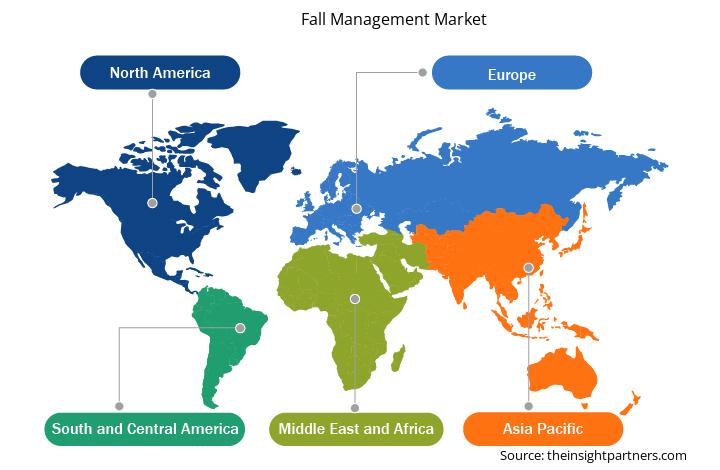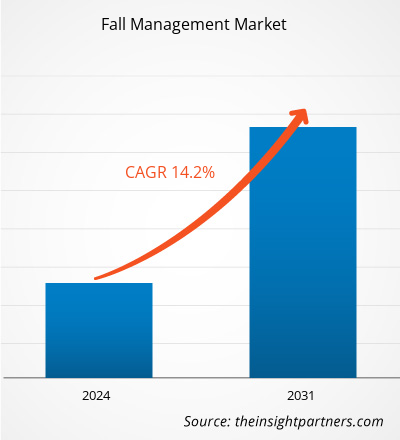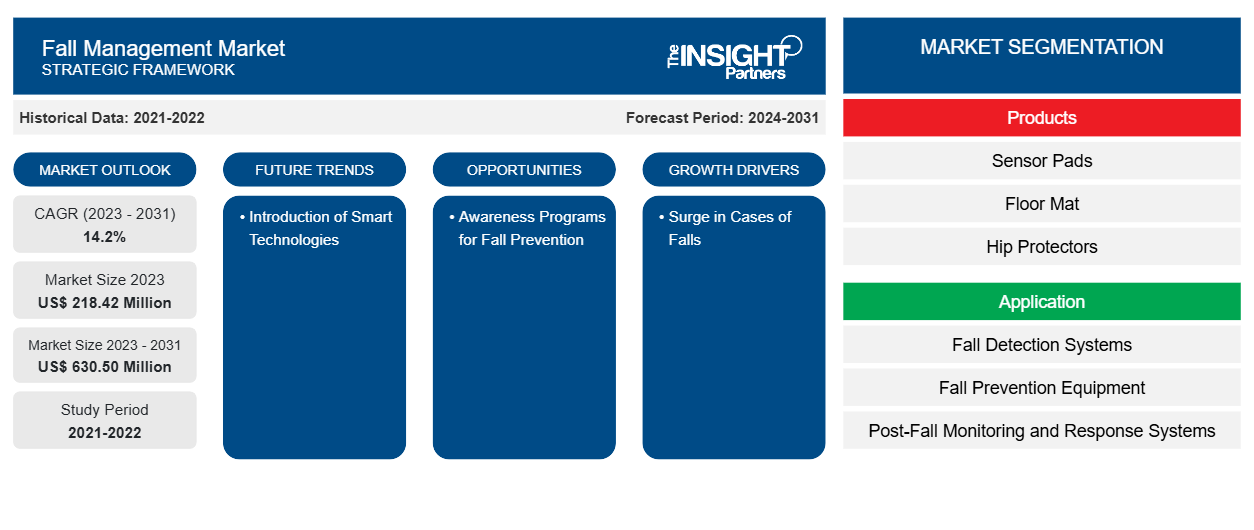Der Markt für Fallmanagement soll von 218,42 Millionen US-Dollar im Jahr 2023 auf 630,50 Millionen US-Dollar im Jahr 2031 anwachsen. Der Markt wird zwischen 2023 und 2031 voraussichtlich eine durchschnittliche jährliche Wachstumsrate (CAGR) von 14,2 % verzeichnen. Die Integration intelligenter Technologien in die Reinraumtechnik dürfte in den kommenden Jahren neue Trends auf den Markt bringen.
Marktanalyse für Herbstmanagement
Eine Kombination aus evidenzbasierten Praktiken, technologischen Fortschritten und einem wachsenden Bewusstsein für die Folgen von Stürzen bei älteren Menschen treibt das Sturzmanagement bei Erwachsenen zunehmend voran. Angesichts der alternden Bevölkerung erkennen Gesundheitsdienstleister die Notwendigkeit umfassender Sturzpräventionsstrategien, die Risikobewertung, Umgebungsanpassungen und Patientenaufklärung umfassen. Die Implementierung standardisierter Tools zur Sturzrisikobewertung ermöglicht es dem Gesundheitspersonal, Personen mit hohem Risiko frühzeitig zu identifizieren und maßgeschneiderte Interventionen zu ermöglichen. Darüber hinaus bietet die Integration von Technologien wie tragbaren Sensoren und Smart-Home-Geräten erhebliche Möglichkeiten, Bewegungsmuster zu überwachen und Pflegekräfte in Echtzeit zu warnen, was die Sicherheit erhöht. Aufklärungsprogramme für Patienten und Gesundheitspersonal sind unerlässlich, um eine Kultur der Sicherheit und des Bewusstseins für Sturzrisiken zu fördern. Initiativen zur Einbindung der Gemeinschaft, wie z. B. Trainingsprogramme zur Verbesserung von Gleichgewicht und Kraft, befähigen Einzelpersonen weiter, proaktive Maßnahmen zu ergreifen. Da die Richtlinien zunehmend eine patientenzentrierte Versorgung betonen, bietet sich eine einzigartige Gelegenheit für eine interdisziplinäre Zusammenarbeit zur Verbesserung der Sturzmanagementprotokolle. Durch die Nutzung dieser Treiber und Möglichkeiten können Gesundheitssysteme Sturzvorfälle erheblich reduzieren, die Patientenergebnisse verbessern und das allgemeine Wohlbefinden von Erwachsenen fördern, insbesondere in Einrichtungen der Langzeitpflege und Rehabilitation.
Überblick zum Herbstmanagement-Markt
Laut der Weltgesundheitsorganisation (WHO) können Stürze zu Immobilität und Einweisungen in Pflegeheime führen, zudem sind sie weltweit die häufigste Todesursache. Die Centers for Disease Control and Prevention (CDC) bezeichnen Stürze als einen wichtigen Faktor, der Menschen ab 65 Jahren betrifft und schwere Verletzungen verursachen kann. Mehr als 14 Millionen Menschen, also jeder vierte ältere Erwachsene, berichten jedes Jahr von Stürzen unterschiedlicher Intensität. Einem Bericht der Bevölkerungsabteilung der Vereinten Nationen zufolge betrug die geriatrische Bevölkerung der Welt im Jahr 2021 etwa 600 Millionen Menschen, und diese Zahl soll bis 2050 auf 2 Milliarden ansteigen. Darüber hinaus führt laut einer im Jahr 2024 vom CDC veröffentlichten Statistik jeder zehnte Sturz bei älteren Menschen zu Verletzungen, die zu Einschränkungen ihrer täglichen Aktivitäten für einen Tag oder länger führen oder sie zu einer medizinischen Behandlung zwingen. Jedes Jahr suchen ältere Erwachsene etwa 3 Millionen Mal die Notaufnahme auf, um wegen Stürzen behandelt zu werden. Darüber hinaus kommt es in dieser Bevölkerungsgruppe jährlich zu etwa 1 Million sturzbedingten Krankenhauseinweisungen. Stürze sind auch die häufigste Ursache für traumatische Hirnverletzungen (TBIs). Daher macht die zunehmende Sturzhäufigkeit zusammen mit der Alterung der Bevölkerung die Entwicklung von Sturzmanagementsystemen und -lösungen erforderlich.
Unternehmen investieren in fortschrittliche Technologien zur Sturzprävention und -erkennung. Im Februar 2024 führte Dozee, ein indisches Startup, eine innovative Fall Prevention Alert (FPA)-Funktion in sein auf künstlicher Intelligenz (KI) basierendes, berührungsloses Patientenfernüberwachungs- (RPM) und Frühwarnsystem (EWS) ein. Die FPA-Funktion soll die Patientensicherheit in Krankenhäusern revolutionieren. Securitas Healthcare ist eines der Unternehmen, das Lösungen zur Überwachung und Reduzierung von Patientenstürzen durch den Einsatz fortschrittlicher Sturzwarnsysteme anbietet. Das Unternehmen arbeitet mit vertrauenswürdigen Partnern zusammen, um die Patientensicherheit in Krankenhäusern zu verbessern, indem es sie bei der Implementierung wirksamer Sturzmanagementprotokolle unterstützt.
Laut einem Artikel, der 2021 im Journal of Current Medical Research and Opinion veröffentlicht wurde, sind Ausrutscher, Stolperer und Stürze die zweithäufigste Ursache für verlorene Arbeitstage im US-Gesundheitssektor. Auch die Hartford Financial Services Group zählt diese drei zu den häufigsten Schadensarten, die zusammen 66 % aller Schadensfälle im Gesundheitswesen ausmachen . Damit stellen sie für viele Branchen eine erhebliche Verlustquelle dar. Die Marktteilnehmer konzentrieren sich auf die Bereitstellung von Lösungen zur Sturzprävention in Gesundheitseinrichtungen. Im März 2024 ging HD Nursing, ein führendes Unternehmen für Patientensicherheitslösungen, eine Partnerschaft mit WellnessMats ein, einem führenden Anbieter von erstklassigen Stehlösungen. Ziel dieser Zusammenarbeit war es, Komfort und Sicherheit zu verbessern und gleichzeitig Müdigkeit und Stress für medizinisches Fachpersonal in Krankenhäusern und Gesundheitssystemen zu reduzieren. Solche Kooperationen und Investitionen von Unternehmen zur Bewältigung der steigenden Zahl von Stürzen werden das Wachstum des Marktes für Sturzmanagement im Prognosezeitraum ankurbeln.
Passen Sie diesen Bericht Ihren Anforderungen an
Sie erhalten kostenlos individuelle Anpassungen an jedem Bericht, einschließlich Teilen dieses Berichts oder einer Analyse auf Länderebene, eines Excel-Datenpakets sowie tolle Angebote und Rabatte für Start-ups und Universitäten.
-
Holen Sie sich die wichtigsten Markttrends aus diesem Bericht.Dieses KOSTENLOSE Beispiel umfasst eine Datenanalyse von Markttrends bis hin zu Schätzungen und Prognosen.
Treiber und Chancen auf dem Herbstmanagementmarkt
Zunehmende Präferenz für häusliche Pflege fördert Marktwachstum
Da ältere Menschen Pflege zu Hause bevorzugen, liegt der Fokus zunehmend auf Sturzmanagementlösungen, die für die häusliche Pflege geeignet sind. Tragbare Alarmsysteme und rutschfeste Matten, die speziell für den Einsatz in Wohngebäuden entwickelt wurden, erfreuen sich bei Pflegekräften und Patientenfamilien immer größerer Beliebtheit. Die Hersteller konzentrieren sich auf die Benutzerfreundlichkeit von Sturzmanagementlösungen für die häusliche Pflege, damit Senioren ihre Unabhängigkeit bewahren und gleichzeitig ihre Sicherheit gewährleistet bleibt. Dieser Trend zur Unabhängigkeit spiegelt eine breitere Bewegung hin zu personalisierten Pflegemodellen wider, bei denen Komfort und Zugänglichkeit bei der Bewältigung von Gesundheitsrisiken zu Hause im Vordergrund stehen. Im Juli 2024 kündigte Gamgee die Einführung des Gamgee Wi-Fi-Absturzschutzes zur Sicherheit älterer Menschen an. Dieses innovative System nutzt vorhandene Wi-Fi-Netzwerke, um eine umfassende Lösung für die Altenpflege bereitzustellen. Es geht auf die wachsende Nachfrage nach effektiven Sturzerkennungs- und Notfallreaktionssystemen ein und ermöglicht es Senioren, unabhängig und sicher in ihren eigenen vier Wänden zu leben.
Die Personalisierung von Sturzpräventionsprogrammen wird immer wichtiger, da Gesundheitsdienstleister erkennen, dass die Bedürfnisse von Patient zu Patient sehr unterschiedlich sein können. Maßgeschneiderte Interventionen auf der Grundlage spezifischer Risikofaktoren wie eingeschränkter Mobilität oder kognitiver Beeinträchtigungen gewinnen an Bedeutung. Gesundheitseinrichtungen werden wahrscheinlich umfassende Beurteilungen durchführen, die individuelle Sturzmanagementstrategien für jeden Patienten liefern. Dieser Ansatz der Anpassung von Sturzmanagementlösungen für die häusliche Pflege verbessert nicht nur die Wirksamkeit von Interventionen, sondern fördert auch eine stärkere Einbindung der Patienten in ihre eigenen Pflegepläne. Somit treibt die zunehmende Präferenz für die Altenpflege zu Hause den Fortschritt des Sturzmanagementmarktes voran.
Sensibilisierungsprogramme zur Sturzprävention schaffen Wachstumschancen
Der Markt für Sturzmanagement dürfte wachsen, da das Bewusstsein für die Notwendigkeit der Sturzprävention bei Gesundheitsdienstleistern, Patienten und Familien zunimmt. Laut einem im Juli 2021 in PubMed Central veröffentlichten Artikel erreichte die Zahl der Stipendiaten der evidenzbasierten Sturzpräventionsprogramme (EBFPPs) der Administration for Community Living zwischen 2014 und 2019 über 85.000 ältere Erwachsene. Die Teilnahme an den EBFPPs führte zu mehr Selbstvertrauen, geringerer Angst vor Stürzen und einer Verringerung sowohl von Stürzen als auch von Stürzen mit Verletzungen. Darüber hinaus haben Aufklärungskampagnen, die das Sturzrisiko und die erheblichen Folgen hervorheben, Gesundheitseinrichtungen motiviert, Sturzpräventionsprogramme zu betonen. Die CDC startete 2012 die Initiative STEADI (Stopping Elderly Accidents, Deaths, and Injuries), um Gesundheitsdienstleistern dabei zu helfen, Stürze bei älteren Erwachsenen zu verhindern. Dieses Programm konzentriert sich darauf, Gesundheitsdienstleistern Instrumente zur Bewertung des Sturzrisikos, Aufklärungsmaterialien für Patienten und evidenzbasierte Interventionsstrategien bereitzustellen. Das CDC arbeitet mit Gesundheitseinrichtungen zusammen, um Risikopatienten zu identifizieren und Maßnahmen wie Trainingsprogramme und Sicherheitsbewertungen zu Hause zu fördern, um durch das Engagement der Gemeinschaft und die Schulung des Anbieters Sturzunfälle zu reduzieren.
Im April 2024 startete Connect America, ein führender Anbieter virtueller Pflegelösungen, ein Sturzpräventionsprogramm, um älteren Menschen und allen Menschen mit chronischen Krankheiten zu helfen, sicher in ihren eigenen vier Wänden zu leben. Dieses umfassende Programm konzentriert sich auf die Erkennung und Vorhersage von Sturzrisiken und bietet gleichzeitig Aufklärung und Unterstützung, um Sturzfälle bei älteren und gefährdeten Bevölkerungsgruppen zu reduzieren. Daher unterstreicht der Wandel hin zu proaktiver Pflege die Bedeutung effizienter Sturzmanagementsysteme und schafft letztlich Marktaussichten für Unternehmen, die neuartige Produkte anbieten, die diese wachsenden Erwartungen erfüllen sollen.
Segmentierungsanalyse des Marktberichts zum Herbstmanagement
Wichtige Segmente, die zur Ableitung der Marktanalyse zum Sturzmanagement beigetragen haben, sind Produkt, Anwendung, Altersgruppe, Endbenutzer und Geografie.
- Der Markt für Sturzmanagement ist nach Produkten segmentiert in Sensorpads, Bodenmatten, Hüftprotektoren, Alarmsysteme, Kommunikationsgeräte und andere Produkte. Das Segment der Alarmsysteme hatte 2023 den größten Anteil am Markt für Sturzmanagement und wird voraussichtlich zwischen 2023 und 2031 eine signifikante CAGR verzeichnen.
- Basierend auf der Anwendung ist der Markt in Sturzerkennungssysteme, Sturzpräventionsgeräte und Überwachungs- und Reaktionssysteme nach Stürzen segmentiert. Das Segment Sturzerkennungssysteme hielt im Jahr 2023 den größten Anteil am Sturzmanagementmarkt.
- Der Markt für Sturzmanagement ist nach Altersgruppen unterteilt in ältere Bevölkerung (65 und älter) und Erwachsene (18–64 Jahre). Das Segment der älteren Bevölkerung (65 und älter) hatte 2023 den größten Anteil am Markt für Sturzmanagement und wird voraussichtlich zwischen 2023 und 2031 eine signifikante CAGR verzeichnen.
- Basierend auf dem Endverbraucher ist der Markt in Krankenhäuser und Kliniken, Pflegeheime, häusliche Pflegeeinrichtungen und andere Endverbraucher segmentiert. Das Segment Krankenhäuser und Kliniken hielt im Jahr 2023 den größten Anteil am Markt für Sturzmanagement.
Marktanteilsanalyse für Herbstmanagement nach geografischer Lage
Der geografische Umfang des Marktberichts zum Sturzmanagement ist hauptsächlich in fünf große Regionen unterteilt: Nordamerika, Europa, Asien-Pazifik, Naher Osten und Afrika sowie Süd- und Mittelamerika. Nordamerika dominierte den Markt im Jahr 2023. Das Marktwachstum in der Region ist auf die Präsenz wichtiger Marktteilnehmer, die frühe Akzeptanz fortschrittlicher Technologien und eine gut etablierte Gesundheitsinfrastruktur zurückzuführen. Stürze sind die Hauptursache für Verletzungen und Todesfälle bei älteren Menschen. Daher wächst das Bewusstsein für Lösungen und Technologien zum Sturzmanagement in den USA mit der zunehmenden geriatrischen Bevölkerung, da der Gesundheitssektor des Landes stark auf technologische Fortschritte angewiesen ist, um wirksame Behandlungen bereitzustellen und die Lebenserwartung weiter zu verlängern. Die Centers for Disease Control and Prevention (CDC) berichten, dass im Land jedes Jahr etwa 25 % der älteren Erwachsenen stürzen, was die Dringlichkeit wirksamer Strategien zur Sturzprävention und -behandlung unterstreicht. Infolgedessen haben sowohl der öffentliche als auch der private Gesundheitssektor ihre Bemühungen verstärkt, Sturzrisiken durch verschiedene Initiativen und Strategien zur Sensibilisierung für die Ursachen und Prävention von Stürzen sowie für die Bedeutung von Früherkennungs- und Reaktionssystemen anzugehen.
Gesundheitsdienstleister, Langzeitpflegeeinrichtungen und Rehabilitationszentren führen proaktiv Sturzmanagementprogramme ein und integrieren Sturzrisikobewertungen, Kraftaufbauübungen und Gleichgewichtstraining in die Routineversorgung älterer Menschen. So kündigte Connect America, ein landesweit anerkannter Innovator für virtuelle Pflegelösungen, die älteren Menschen und Menschen mit chronischen Erkrankungen ein sicheres und gutes Leben zu Hause ermöglichen, im April 2024 den Start seines innovativen Sturzpräventionsprogramms an. Das Sturzpräventionsprogramm von Connect America zielt darauf ab, dieses Problem durch die Implementierung innovativer vernetzter Gesundheitstechnologien wie virtueller KI-Interaktion, prädiktiver Analytik und Supportservices anzugehen, um gefährdete Personen zu identifizieren und vorherzusagen und präventive Pflegemaßnahmen bereitzustellen, um das Sturzrisiko zu minimieren oder die Intensität einer Sturzverletzung zu mildern.
Unternehmen in den USA bemühen sich, die Zugänglichkeit und Erschwinglichkeit durch Partnerschaften mit staatlichen Programmen wie Medicare und Medicaid zu verbessern, die begonnen haben, bestimmte Managementlösungen wie Sturzerkennungsgeräte abzudecken. Darüber hinaus erkennen Gesundheitsdienstleister und Versicherungsunternehmen zunehmend die finanziellen Vorteile von Investitionen in die Sturzprävention, da sie die Kosten für Sturzverletzungen senken können, deren Behandlung und Behandlung teuer sind. Mit zunehmendem Bewusstsein werden Sturzmanagementlösungen stärker in das breitere Gesundheitssystem integriert. Daher wächst der US-Sturzmanagementmarkt schnell, und es werden anhaltende Bemühungen unternommen, das Bewusstsein zu schärfen, die Zugänglichkeit zu verbessern und die Erschwinglichkeit zu steigern, um eine breite Einführung von Sturzpräventions- und -managementlösungen sicherzustellen.
Regionale Einblicke in den Herbstmanagementmarkt
Die regionalen Trends und Faktoren, die den Markt für Herbstmanagement im Prognosezeitraum beeinflussen, wurden von den Analysten von Insight Partners ausführlich erläutert. In diesem Abschnitt werden auch die Marktsegmente und die Geografie des Marktes für Herbstmanagement in Nordamerika, Europa, im asiatisch-pazifischen Raum, im Nahen Osten und Afrika sowie in Süd- und Mittelamerika erörtert.

- Holen Sie sich regionale Daten zum Markt für Herbstmanagement
Umfang des Marktberichts zum Herbstmanagement
| Berichtsattribut | Details |
|---|---|
| Marktgröße im Jahr 2023 | 218,42 Millionen US-Dollar |
| Marktgröße bis 2031 | 630,50 Millionen US-Dollar |
| Globale CAGR (2023 - 2031) | 14,2 % |
| Historische Daten | 2021-2022 |
| Prognosezeitraum | 2024–2031 |
| Abgedeckte Segmente |
Nach Produkten
|
| Abgedeckte Regionen und Länder |
Nordamerika
|
| Marktführer und wichtige Unternehmensprofile |
|
Dichte der Marktteilnehmer im Herbstmanagement: Die Auswirkungen auf die Geschäftsdynamik verstehen
Der Markt für Fallmanagement wächst rasant, angetrieben durch die steigende Nachfrage der Endnutzer aufgrund von Faktoren wie sich entwickelnden Verbraucherpräferenzen, technologischen Fortschritten und einem größeren Bewusstsein für die Vorteile des Produkts. Mit steigender Nachfrage erweitern Unternehmen ihr Angebot, entwickeln Innovationen, um die Bedürfnisse der Verbraucher zu erfüllen, und nutzen neue Trends, was das Marktwachstum weiter ankurbelt.
Die Marktteilnehmerdichte bezieht sich auf die Verteilung der Firmen oder Unternehmen, die in einem bestimmten Markt oder einer bestimmten Branche tätig sind. Sie gibt an, wie viele Wettbewerber (Marktteilnehmer) in einem bestimmten Marktraum im Verhältnis zu seiner Größe oder seinem gesamten Marktwert präsent sind.
Die wichtigsten auf dem Herbstmanagementmarkt tätigen Unternehmen sind:
- Alimed Inc
- Curbell, Inc
- DeRoyal Industries Inc
- Emfit GmbH
- Rondish Company Limited
- Smart Caregiver Corporation
Haftungsausschluss : Die oben aufgeführten Unternehmen sind nicht in einer bestimmten Reihenfolge aufgeführt.

- Überblick über die wichtigsten Akteure auf dem Herbstmanagementmarkt
Neuigkeiten und aktuelle Entwicklungen zum Herbstmanagementmarkt
Der Markt für Herbstmanagement wird durch die Erhebung qualitativer und quantitativer Daten nach Primär- und Sekundärforschung bewertet, die wichtige Unternehmenspublikationen, Verbandsdaten und Datenbanken umfasst. Nachfolgend sind einige der wichtigsten Entwicklungen auf dem Markt für Herbstmanagement aufgeführt:
- Bay Alarm Medical, ein führendes Unternehmen für medizinische Alarmsysteme, hat sein neues mobiles Alarmsystem SOS Micro herausgebracht. Das System ist eine Aktualisierung der beliebten medizinischen Alarmangebote des Unternehmens, verfügt jedoch über neuere, kleinere Hardware. (Quelle: Bay Alarm Medical, Unternehmenswebsite, Oktober 2024)
- Tunstall Healthcare, ein Anbieter vernetzter Pflege- und Gesundheitslösungen, hat mit Tunstall GO ein neues und innovatives Produkt auf den Markt gebracht, das Zweiwege-Sprache, Sturzerkennung und Ortung bietet. Das von Chiptech entwickelte Produkt ergänzt Telecare-Pakete, indem es Benutzern die Möglichkeit bietet, auch unterwegs problemlos auf Hilfe zuzugreifen. (Quelle: Tunstall Healthcare, Unternehmenswebsite, März 2021).
Abdeckung und Ergebnisse des Marktberichts zum Herbstmanagement
Der Bericht „Marktgröße und Prognose für Herbstmanagement (2021–2031)“ bietet eine detaillierte Analyse des Marktes, die die folgenden Bereiche abdeckt:
- Marktgröße und Prognose für Herbstmanagement auf globaler, regionaler und Länderebene für alle wichtigen Marktsegmente, die im Rahmen des Berichts abgedeckt sind
- Markttrends im Herbstmanagement sowie Marktdynamiken wie Treiber, Beschränkungen und wichtige Chancen
- Detaillierte PEST- und SWOT-Analyse
- Herbstmanagement-Marktanalyse mit wichtigen Markttrends, globalen und regionalen Rahmenbedingungen, wichtigen Akteuren, Vorschriften und aktuellen Marktentwicklungen
- Branchenlandschaft und Wettbewerbsanalyse, die die Marktkonzentration, Heatmap-Analyse, prominente Akteure und aktuelle Entwicklungen für den Herbstmanagementmarkt umfasst
- Detaillierte Firmenprofile
- Historische Analyse (2 Jahre), Basisjahr, Prognose (7 Jahre) mit CAGR
- PEST- und SWOT-Analyse
- Marktgröße Wert/Volumen – Global, Regional, Land
- Branchen- und Wettbewerbslandschaft
- Excel-Datensatz
Aktuelle Berichte
Verwandte Berichte
Erfahrungsberichte
Grund zum Kauf
- Fundierte Entscheidungsfindung
- Marktdynamik verstehen
- Wettbewerbsanalyse
- Kundeneinblicke
- Marktprognosen
- Risikominimierung
- Strategische Planung
- Investitionsbegründung
- Identifizierung neuer Märkte
- Verbesserung von Marketingstrategien
- Steigerung der Betriebseffizienz
- Anpassung an regulatorische Trends























 Kostenlose Probe anfordern für - Herbstmanagementmarkt
Kostenlose Probe anfordern für - Herbstmanagementmarkt